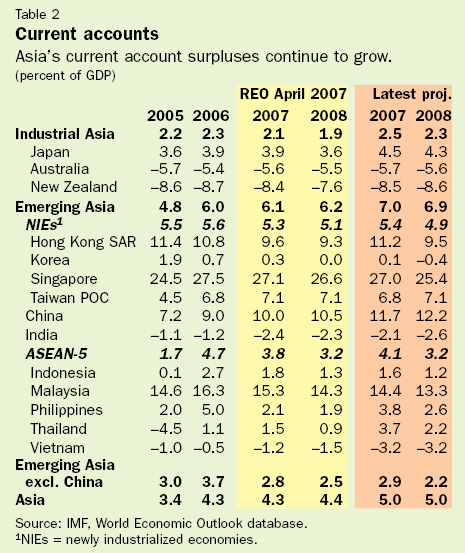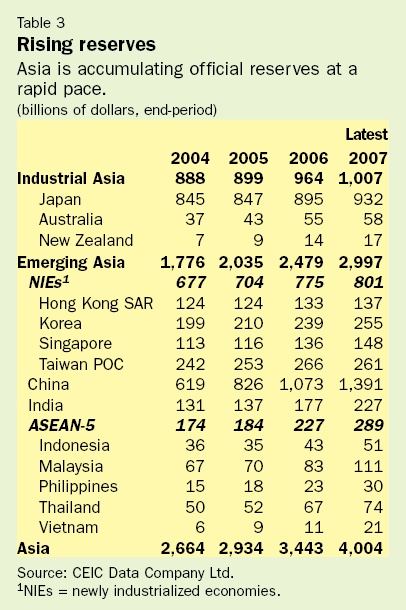Asia Forecast to Keep Up Strong Growth
Location: New York
Author:
Paul Gruenwald
Date: Monday, October 22, 2007
- Export growth has increased sharply, led by demand from Europe
- Food prices have raised headline inflation in some countries
- Pattern of lower export, investment growth expected across much of region
Growth in Asia has trended higher this year and the strong performance is forecast to continue into 2008.
For the region as a whole, growth is expected to reach 8.0 percent in 2007 before moderating to 7.2 percent next year, according to the IMF's latest Regional Economic Outlook (REO) for Asia and the Pacific.
Growth continues to be driven by China and India (see Table 1), while the newly industrialized economies and the ASEAN-5 (Indonesia, Malaysia, the Philippines, Thailand, and Vietnam) have also done well reflecting a pickup in domestic demand. Following a soft patch earlier this year, export growth, including the important electronics sector, has increased sharply led by demand from Europe, said David Burton, Director of the IMF's Asia and Pacific Department, at an October 19 press briefing.

According to the REO, inflation pressures remain largely under control. While food prices have raised headline numbers in some countries, core inflation has been well behaved. This is particularly true in China, where prices for a handful of agricultural products have spiked owing to supply factors, sending headline inflation to a decade high of 6˝ percent. However, there has been little evidence thus far of second round effects.
The region has continued to experience large current account surpluses and continued capital inflows (see Tables 2 and 3). However, exchange rates have appreciated only modestly in most countries as intervention by central banks has pushed regional reserves past the $4 trillion mark, with China continuing to account for the bulk of the increase.

Asia was not at the epicenter of the global financial market turmoil that broke out in July, and markets and financial institutions in the region have held up well. Direct exposure to U.S. sub-prime mortgages and, more broadly, to leveraged and complex structured credit was reportedly small, including for hedge funds. Most markets have recovered the losses experienced after the turbulence began, and in some cases have attained new highs.

The outlook for Asia assumes a slowing of external demand from the United States and Europe as well as an effective policy tightening in China. A pattern of somewhat slower export and investment growth across much of the region is expected, with only some de-linking from the global cycle. The region's current account surplus is projected to rise to 5 percent of GDP owing largely to China, where the trade surplus continues to surge.
The risks to this outlook are balanced, although they are not uniform across countries. For China and India the risks are on the upside and relate to the pace of investment—to the extent that investment is currently growing too fast, higher than expected growth would not necessarily be beneficial. For most of the rest of the region, the risks are on the downside, and relate mainly to sharply slower foreign demand growth in major export markets.
Regarding policies, in the event that growth slows more than expected, the IMF sees scope for easing monetary policy settings in much of the region, except for those few countries where inflation pressures remain relatively high. Most countries also have "fiscal space" available to counter any growth slowdown by letting the automatic stabilizers work.
It is not too early to draw preliminary policy lessons from the recent market turbulence, which will become increasingly important as Asia's financial institutions become more sophisticated. Actions could include strengthening reporting requirements to ensure greater transparency, enhancing pricing and provisioning to reduce liquidity and solvency risks, and improving disclosure requirements to better inform investors of their risk exposures.
In addition to the forecasts, the REO includes three chapters on different aspects of the Asian economy:
Against the background of the recent financial market turbulence, which roughly coincided with the tenth anniversary of the crisis, Chapter II of the REO analyzes the question "How Much Stronger is Asia?" It also seeks to respond to a number of prominent commentators, who have argued that Asia has not learned the right lessons from the crisis.
Burton at Asian Regional Economic Outlook briefing: "China and India represent remarkable success stories" (IMF photo)
The chapter looks at potential vulnerabilities across a number of metrics and concludes that Asia has come a long way as a result of financial sector and corporate governance reforms as well as significant improvements in monetary policy frameworks. While pockets of vulnerability reflecting elevated asset prices are present in some markets, and the region-wide challenges relating to ongoing integration into the global economy remain, Asia is much more resilient to shocks than ten years ago.
With official reserves in Asia now exceeding $4 trillion, has currency market intervention been effective in influencing the level, rate of change, or volatility of exchange rates? Chapter III of the REO investigates this issue, and finds only modest evidence that intervention reduces exchange rate volatility. (Of note, the study did not look at economies with fixed or tightly managed exchange rates, including China.) Moreover, no evidence was found indicating that intervention influences the level or rate or change of the exchange rate on a sustained basis.
While perhaps surprising, these results are consistent with the stated objectives of some monetary authorities in the region as well as with authorities "leaning against the wind" to curb appreciation. One should also take into account that the analysis was constrained by the use of monthly reserve data and by methodological challenges.
Chapter IV of the REO takes an in-depth look at the evolution of trade in Asia. It finds that the importance of exports to the region's economies remains as high as ever, confirming that the expanded presence of emerging Asia in world trade has resulted largely from intra-regional integration. This, in turn, reflects the ongoing development of specialized supply chains, with China playing the role as a final assembly point.
However, the study is also finds evidence that emerging Asia has begun to move away from a concentration in lower-end exports toward more sophisticated products, and that the degree of competition within Asia is intensifying. The implications? Claims that Asia is delinking from the rest of the world may be premature, and export dynamism continues across the spectrum of Asian economies.

To subscribe or visit go to: http://www.riskcenter.com